Saturday, March 14, 2009, 08:24 PM - Servicing
There are some interesting lenses available from under the Vivitar and Soligor brands using the T4 mount. Adapters are available for several mounts, including m42, which can then be used on various modern cameras.However, there is a small issue: if your m42 adapter is not pushing the rear diaphragm pin, you will have to use the M/A switch on the side of the adapter. This would not be an issue if it could be locked either into Manual or Auto position, but the switch on the T4 to m42 adapter is spring loaded, so you have to hold it in order to close the diaphragm.
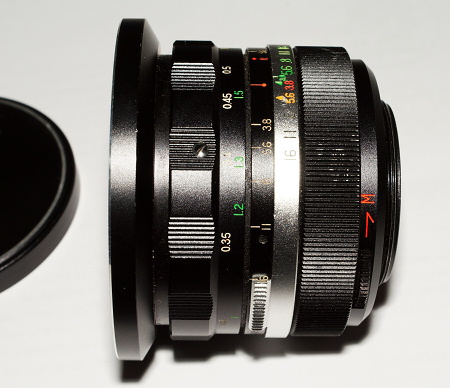
The "M" switch at the rear of the lens (on the T4 to m42 adapter)
First, here is now to know that a lens is a T4 (or TX) lens: there is a double aperture scale (it goes on both directions), and the lens features a O/L (Open/Lock) locking mechanism for the mount adapter which protrudes from the lens.
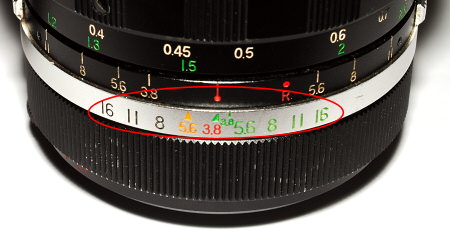
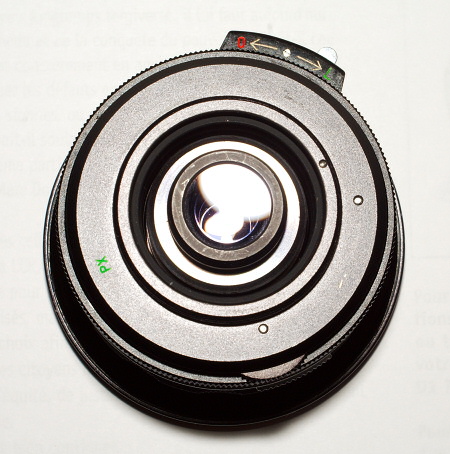
Now, we are going to find a way to keep the diaphragm closed without having to hold the "M" switch.
Remove the T4 adapter from the lens:
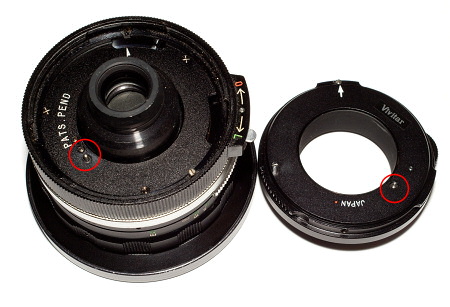
On the lens, we can see the pin which actuates the aperture: when it is pushed by the mount adapter, the diaphragm is opened, and closed otherwise.
Open the adapter by removing the side screws:
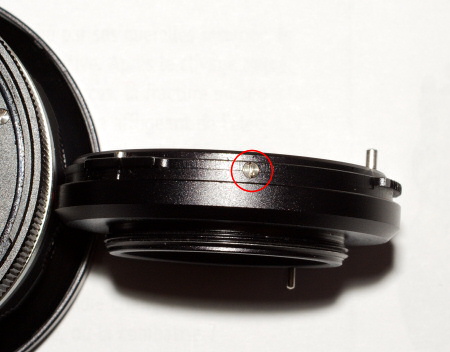
Here is the opened adapter:
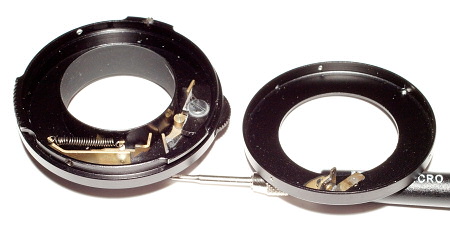
Remove the spring:
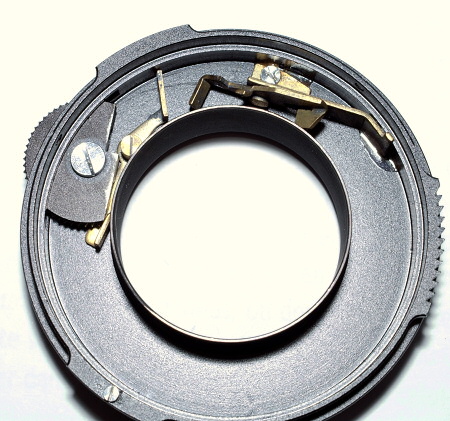
This is enough to keep the aperture closed when the adapter is put back onto the lens, but now the cams are freely moving inside the adapter.
We are going to try mounting the M switch in reversed position. As it is asymmetric, that should be enough the prevent it from moving.
Remove the axis:
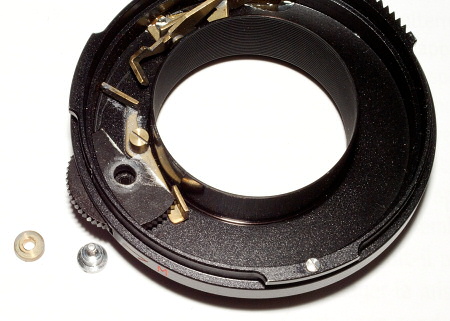
(the silver part is from the top, and the golden part is from under)
Now, remove this other axis:
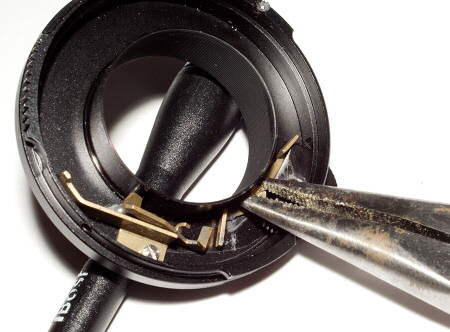
We are now able to remove the M switch:
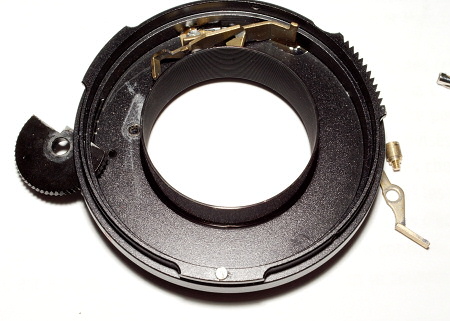
And put it back, but in reversed position:
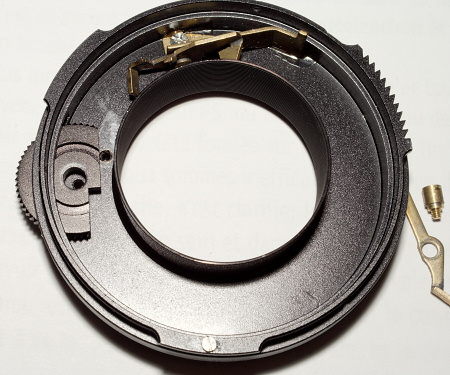
Unfortunately, it is only at this stage that I noticed that this was NOT enough to keep the M switch in the right position and prevent it from moving.
So let's put a piece of rubber (cut from an eraser) there in order to lock it:

We can now put the spring back, and close the adapter. The part which was previously pushing the diaphragm pin in the lens (this opening the diaphragm) is now recessed:

Of course, now I know that it would have been easier to just open the adapter and lock the cam with the piece of rubber, without any need to remove the spring or revert the M switch.
| 0 trackbacks
| permalink
| related link
Tuesday, February 3, 2009, 04:33 PM - Photography
Lenses coating dates back from 1935, when it was invented by Alexander Smakula, working for Carl Zeiss. While multi-layers coating (multi-coating) was invented in 1938 by Katharine Burr (at General Electric), it was not widely used on camera lenses untill the 70s.Early multi-coating were easily scratched (or even wiped), so during a lot of years only single layer coatings were used.
During the late 60s, there was a cooperation between Asahi (the company which was latter renamed as Pentax) and Carl Zeiss Oberkochen. At this time, Zeiss was trying to partner with a Japanese manufacturer in order to produce a range of SLR cameras. (but finally partnered with Yashica to produce the Contax SLR)
The result of this cooperation brought the K mount (designed by Zeiss), the 15/3.5 rectilinear lenses (with some variations between the Asahi and Zeiss versions), and a new multicoating process. (it is unclear which company played the most important part within this)
This process allowed to apply resistant multicoating at a reasonable cost, and to increase the number of coating layers. The resulting multi-coating was said to only have a light loss of 0.2% per surface, ie a transmission factor of 0.998.
In 1972, Asahi used their strong multi-coating as a marketing argument, introducing the "Super Multi Coated" lenses (renamed to "SMC" slightly after), and claiming to use up to 9 coating layers.
Zeiss, which was then using a similar coating (same process but potentially different chemicals) renamed their T coating into T* in 1973, in order to use this as a selling point.
(T coating was originally single layer coating, but was improved through the years)
Those advanced multi coating were really a breakthrough, so competitors quickly reacted to this. Fuji stated that they would start using their EBC multicoating, featuring up to 11 layers, for camera lenses (it was already in use for their cine lenses). Nikon stated they where already using up to 4 coating layers), and Leitz and Canon stated that they were already working on similar multi-coatings.
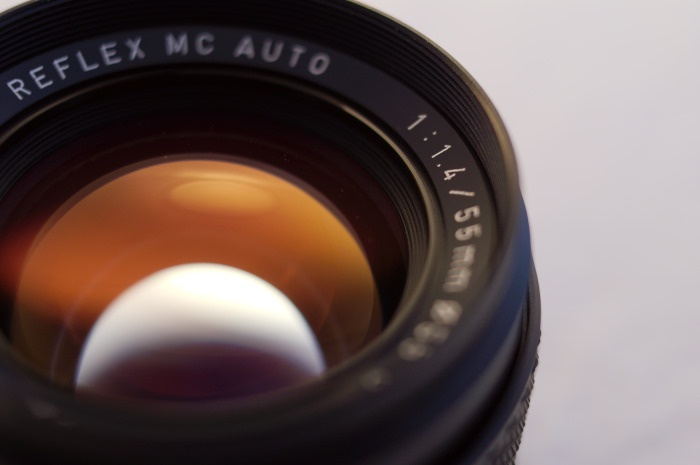
Wednesday, January 14, 2009, 01:01 PM - Photography
So here it is, I finally updated my KM5D. I replaced it by a Pentax K20D, as it is the best choice right now for me, in order to cover my own specific needs.Here is my new everyday camera (yes, it looks a bit like Dr Frankenstein's camera with its red eye and tilted lens ):
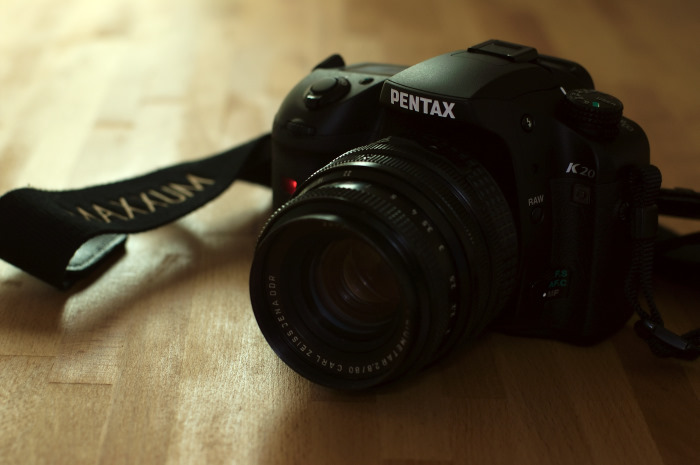
Why I switched...
First, a bit of background in order to grasp how I am shooting.
Three years ago, I was using a digital bridge (Olympus c750), but was annoyed by its ISO performances. Basically, the highest usable ISO setting was 200 ISO and anything higher was usually far too noisy to be pleasing.
During my quest for DSLR I found Dyxum's lens database which told me I would have plenty of choice for lenses including a broad range of second hand ones if I choose a Minolta camera. Lens database, in-body stabilization and an attractive price as shops where clearing Minolta gear sold me over a 5d.
I immediately noticed that the 5d meant way more than higher usable ISO: there was a viewfinder which was actually pleasing to use, and turning the zoom ring by hand was providing an easy and pleasing feeling, totally different from a small low resolution electronic viewfinder and some +/- buttons on the back of the camera. Everything felt way more natural: it was a camera, instead of a disposable electronic device like my previous cameras.
Bought a few lenses I could afford, learned to use this DSLR a bit more, and then... "Oktober fest" 2007 here on Dyxum. I decided to try this "challenge" with one of the few manual lenses I had, the 135/3.5 Sonnar from Carl Zeiss Jenna. This slowed me down a lot, but felt more natural than AF. No more lag when pressing the shutter, and the focus was always where I wanted it to be. Of course it also slowed me down significantly, but my ratio of good photos was way higher than what it was before. Instead of shooting many many pics, I had to shoot only a few ones but better thought ones. The fact that I was not able to zoom also had a good positive impact: after two weeks I started to be used to the focal length, and was able to see more photo opportunities around me than when using a zoom
By the end of the month, I was sold to manual prime lenses.
After a few more months (and a few more lenses), it then became clear that for my current shooting style the important gears were lenses, and that the body was only an accessory which allowed me to use my lenses.
From this point, combined with the releases of the Sony a200/a300/a350 which all removed some features I was using on my 5D, I started to seriously think about becoming "brand independent" regarding my photo gear. The best option in this case was to totally switch to m42 lenses, which would then allow me to using bodies of any brand (with the notable exception of Nikon, unfortunately).
Then, my eyesight decreased a bit more, and I am now unable to shoot without eye glasses. This imply that I can not use my eyepiece magnifier anymore, and so the 5D viewfinder became too small for my taste. My quest for a new body was quite simple, with mainly two possibilities: a700 and K20D. However, the fact that Sony removed A mode from all their new DSLR when using manual lenses really made me think twice about Sony. Pentax, on the other hand, now provides new features each time their are releasing a new camera (like k20D vs k10D), and best of all allows in body stabilization for all lenses, without the need to buy plenty of chipped adapters.
So I decided that I would probably buy a k30D when it will be released, and int the meantime I'd apply the last part of my "freedom" plan: convert a manual Beercan into m42, as this is the only zoom I am sometimes using, and did not found any suitable replacement for it.
But...prices of k20D are being slashed, and Pentax is offering right now a 100€ cash-back on the k20D, so I thought it would be the right moment to update my 5D. (without waiting for the Beercan conversion)
Saturday, November 15, 2008, 11:41 AM - Photography
I've read many times that old pre-digital lenses might not be suitable for use on DSLR because of their weak coating. I was also aware of those tests by Pete Ganzel regarding sensor flare.Short explanation about sensor flare:
Digital sensors are highly reflective (way more than film), and so light coming through the lens can be bounced on the sensor, go back through the lens, and be bounced back from lens elements toward the sensor. This can produce a central flare on pictures.
Even being aware of this, to me the connection between sensor flare and lens coating was only theoretical, as I had never seen any real test of this. This was until I got a 55mm f/1.4 Tomioka lens. This is an old manual lens in m42 screw mount, from way before digital era.
This is the the first lens on which I noticed sensor flare (and until now, my only one). When shooting wide open, there is no noticeable issue, but when closing down aperture, from about f/4 it is producing a central highlighted area with reduced contrast. (sometimes not noticeable, sometimes highly noticeable).
Here is a sample of sensor flare from this Tomioka lens:

On this picture, the aperture shape is very noticeable, which implies that light is bounced from the sensor to a lens element located in front of the aperture before being bounced back.
After a few months, I was able to find a multicoated version of this lens:
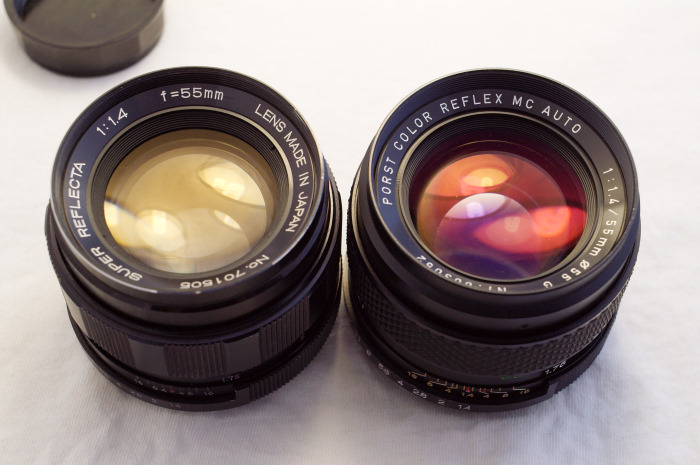
The branding is different, as Tomioka lenses were most often sold as rebadged lenses, but both samples feature the exact same optical design. What can be immediately noticed is that the single coated version mainly exhibits yellow reflections, while the multicoated version exhibits strongly colored reflections.
And then, the multicoating effect proved to be really worthwhile: no more sensor flare noticed on my pictures, whatever the aperture. As both lenses design or otherwise identical, this is an clear demonstration of the multicoating effect regarding digital photography.
Finally, two test shots of a white surface with lenses closed to about f/5.6:
Single coated version of this lens ("Super Reflecta"):

Multi coated version of this lens ("Porst Color Reflex MC Auto"):

Back Next

 Calendar
Calendar




